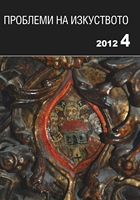Сцената „Житие на праведния монах” и присъствието ѝ в църковната живопис на Балканите
The Scene of the Crucified Monk in Orthodox Painting of the Balkans
Author(s): Elena Genova, Emmanuel MoutafovSubject(s): Fine Arts / Performing Arts
Published by: Институт за изследване на изкуствата, Българска академия на науките
Summary/Abstract: A rarely occurring composition of moral and didactic nature is known in our literature as The Crucified Monk. In the Eastern Orthodox tradition and particularly in the tradition of Mt Athos and Bulgarian tradition stemming from the latter, the composition is titled Ο βίος του αληθούς μοναχού (Vita of a Righteous Monk), while in Russian tradition it occurs under the titles Crucifixion of Passions, A Monk’s Purity, A Legitimate Image of Eldership, A Legitimate Image of Life, Crucifixion of Flesh, etc. The storyline of the crucified monk is rooted in Galatians 6:14, being an intricate symbolic composition representing monastic asceticism in its entirety as striving for the monk’s moral perfection and resisting carnal temptations. The latter are represented as symbolic figures or texts about the seven (deadly) sins. The scene occurs in two iconographic versions. In the early eighteenth century, the composi- tion was described in detail in Hermeneia by Dionysius of Fourna. For the time being the earliest mural on the subject is that of 1699 in the hospital chapel of the Monastery of Horezu, Romania. The article deals with murals dating to the eighteenth and nineteenth century at the Monasteries of Dochiariou and Chilandariou on Mt Athos as well as those at the Monasteries of Ss Peter and Paul, Vithkuq (Albania); of Virgin Mary Ikosifinissa (Serres) and the Sokolsky Monastery (Gabrovo), representing the first iconographic version of the scene. The second version is studied on the wall-paintings at the Monastery of Philotheou on Mt Athos; a print at the Neamt Monastery (Southern Moldova); the Monastery of St John the Forerunner in Serres, as well as in the mural by Toma Vishanov at the Church of the Protecting Veil of the Mother of God at the hermitage of St Luke, the Monastery of Rila. To give a more complete idea of the rise and development of the scene, the Russian tradition is also considered, mostly in Siysky Painters’ Guide (Podlinnik), the album of the Kiev-Pechersk Lavra (Monastery of the Caves) and a print of a Russian folk picture (lubok). At the end, the Western tradition is also considered most of all on examples of Protestant art. The final conclusion is that the com- position draws on the same idea thou differing in terms of the number and diversity of details as well as of some of the texts.
Journal: Проблеми на изкуството
- Issue Year: 2012
- Issue No: 4
- Page Range: 37-46
- Page Count: 10
- Language: Bulgarian
- Content File-PDF

